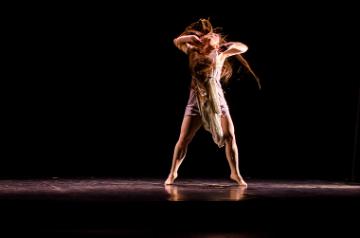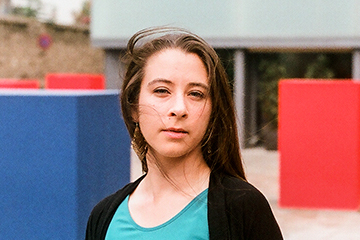
Lauren Baines ’08: Choreographing a Career in the Arts
Q: What do you get when you cross majors in Dance, Art History, and Psychology?
A: A choreographer who produces works whose every nuance brings depth, meaning, and an echo of resonance worth archiving for future study and viewing pleasure.
Lauren Baines ’08 is no joke. This triple major has taken her bachelor’s studies from Santa Clara and her MFA from Mills College to work as a choreographer, performer, and interdisciplinary artist who creates and self-produces theatre and dance throughout the Bay Area.
Her work is being noticed, too.
Lauren was named one of the inaugural recipients of the Leigh Weimers Emerging Artists Awards by the San Jose Rotary Club. She has also been invited to perform her work at Dance Mission Theatre in San Francisco, the ZERO1 Garage in San Jose, Montalvo Arts Center, the de Saisset Museum, and the subZERO Festival.
Of all her works, Lauren’s most satisfying creation to date has been her thesis solo, “at once both prologue and epilogue,” which she created at Mills. This piece is special to her, in part, because she continues to be invited to perform it at venues like sjDANCEco’s ChoreoProject, allowing her to savor the experience, and because it recalls many of the meaningful experiences that led to the creating of the project.
When asked about the influences in her work, Lauren thinks deeply about the impact of her psychology and arts studies. The fine arts influence often comes to her when contemplating a painting that captures her attention long enough to inspire a movement. After taking in a haunting photography exhibit of Nazi concentration camps, for example, a photo of a frozen lake left her thinking – beyond the sadness – about the reflective nature of water, which eventually inspired her to create a dance about falling into water.
This theme of reflection expanded after she participated in a residency in Iceland, a place that captured her artist’s eye with its vibrant colors and geography that made her feel like she was on another planet. While on a canoe ride there, it occurred to her to ruminate on the perfect reflection of the sky in the water and how it might feel to fall into the sky.
While the theme of site dance already intrigued her enough to become the topic of her written MFA thesis, Iceland offered a new setting in which to ponder its power. She contemplated how to take the sensation of dancing in Iceland’s vast open space and bring that feeling into a studio performance.
On the other side of her influences, Lauren’s psychology studies point to the reason her movements are punctuated with such passion. She is intrigued by the ways in which people are driven apart, often due to poor communication. She sees dance as a way to express feelings and emotions in a way that is difficult to misconstrue, making the language of dance a way to bring people together in a world that seems increasingly divided and angry. In addition to her emphasis on communication, Lauren incorporates themes of memory, loss, the unconscious, and identity into her choreography.
Some of the themes that resonate with her started to take hold when she was studying as an undergraduate with SCU dance professor David Popalisky. In particular, she credits his influence in her exploration of gender roles and expectations in dance. Her studies with him exposed her to topics of study that many of her peers didn’t experience until graduate school.
“David Popalisky remains an active force within my growth as an artist and scholar, continuously supporting my new ventures and challenging me to push myself further,” Lauren says. “He helps me question my comfort areas and explore new territory, offering feedback and guidance along the way. In addition to supporting me as a dancer/choreographer and instructor, David takes the time to engage with me in serious conceptual and theoretical discussions, including serving as the second reader for my graduate written thesis and currently working with me on developing a presentation we will deliver together this fall at the Society of Dance History Scholars and Congress on Research in Dance joint conference. In David I have found someone invested in and committed to my ongoing development as an artist, scholar, and person,” she adds.
When reflecting on her time at the University, eight years after graduating, she continues to be amazed by how you enter a family when coming to SCU. “You make incredible friendships that last a lifetime and find collaborators who will be part of your professional and artistic trajectory for years to come. Even though none of my professors is an official “advisor” – no longer “having” to mentor me – these individuals continue to share their knowledge and push me forward,” Lauren says.
Her dream job is to create an interdisciplinary incubator program for a diverse community of artists who share an inspiring space where they can perform and create together. This dream stems from her conviction that art and dance matter.

“Dance allows us to express ourselves and communicate in ways we might not dare to otherwise,” Lauren explains. “But the need for dance is even deeper than that—we are so disconnected from our bodies as we spend our days relying on technology. Dance requires us to be in our bodies and in the moment, which means that we have to forget about outside distractions in order to feel and be.”
Please visit her website for more information.
Photo Credit: Robert Schultze